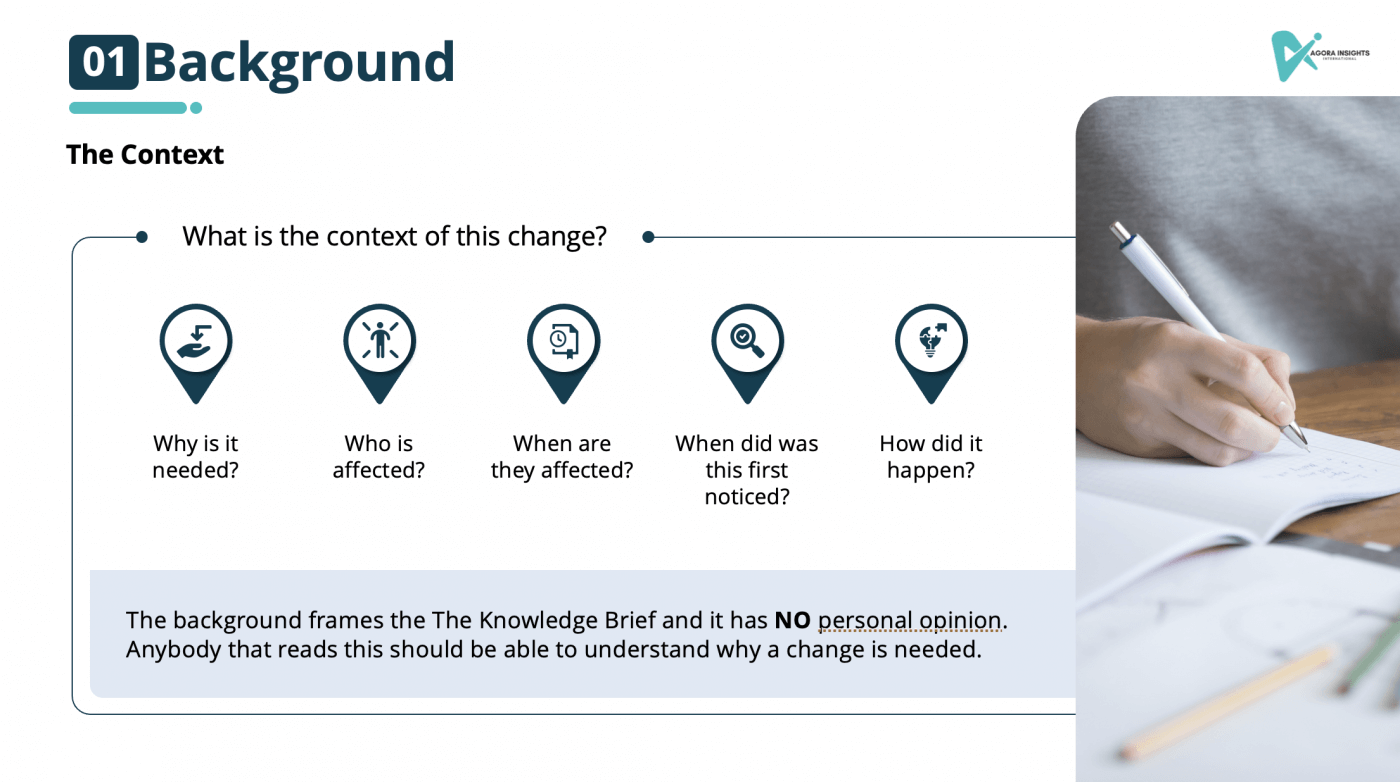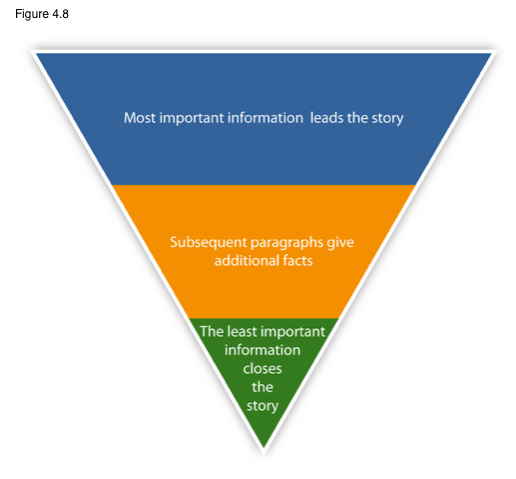The Background Statement
The background statement helps frame the why, who, what, when, where and how of the change initiative allowing all stakeholders to understand the value of the change.
"I write because I don’t know what I think until I read what I say."
— Flannery O’Connor
1.1 Overview

When initiating a change in the organisation, everyone should have a clear understanding of why and what happened to justify the change. However, for many businesses, what happened in the past is not well understood, and yet the change initiative is pushed forwards without clarity of the why, who, what, when, where, and how the change was triggered in the first place. In this post, we'll go over the three elements: meaning, audience, and framing that go into creating an awesome background statement, allowing all stakeholders to be on the same page. To understand the three elements better, let’s use the persona of an investigative journalist.
1.2 Creating meaning with context
"In the late 1800s, a majority of publishers believed that they would sell more papers by reaching out to specific groups. As such, most major newspapers employed a partisan approach to writing, churning out political stories and using news to sway popular opinion. This all changed in 1896 when a then-failing paper, The New York Times, took a radical new approach to reporting: employing objectivity, or impartiality, to satisfy a wide range of readers."[1]
Inspired by objective journalism, this is the approach that we are aiming for when creating our background statement. By providing stakeholders with a clear understanding, we increase clarity and openness, which allows them to deduce the meaning of change. The background statement helps frame the why, who, what, when, where, and how of the change initiative, allowing all stakeholders to understand why this change is needed. It also clarifies the significance of the why, which helps to motivate and direct the initiative. It is unlikely that a great journalist would ignore the background of the case being investigated? Rather, s/he would want to understand what happened, to whom, and work to capture the facts around the story. Thus, the background statement is very similar to a newspaper article. It tells you what happened, who said what, what the consequences were, and what the final result was. But there has to be some depth to the story to make it meaningful. It’s not just a series of data points you throw on a page, no, it's analysing and reasoning the facts associated with the need for the change to construct meaning and thus clarity.
 Like every good piece of journalism, a background statement should be unbiased and not be about the personal opinion of the author. After all, it's not a biography or a memoir. The objective journalist is there to tell a different story, one where they bring in both qualitative and quantitative facts and measurable data, helping to reveal and unpack the situation. This neutral summary frames the why and thus the need for the change, focusing on what has happened in the past to better understand the current business state. This is where the business analyst performs a similar function to that of an investigative journalist, revealing the story behind the events. Here the business analyst will look to answer questions like these:
Like every good piece of journalism, a background statement should be unbiased and not be about the personal opinion of the author. After all, it's not a biography or a memoir. The objective journalist is there to tell a different story, one where they bring in both qualitative and quantitative facts and measurable data, helping to reveal and unpack the situation. This neutral summary frames the why and thus the need for the change, focusing on what has happened in the past to better understand the current business state. This is where the business analyst performs a similar function to that of an investigative journalist, revealing the story behind the events. Here the business analyst will look to answer questions like these:
- What is the situation that requires change?
- Why did this happen?
- Who was affected?
- How did it happen?
- Who was involved?
- What happened?
- Where did it happen?
- When did it happen?
- How was this first noticed?
A good background statement is clear and concise; anyone who reads it should be able to understand why a change is important. Keeping it short can be really tough, and therefore, BAs will need to keep practising and work with their peers to get it right. Remember that building a background statement is an iterative process; we won't necessarily get it absolutely right the first time. Additionally, we might find that the final copy doesn't occur till well into the change project; as we learn more, requirements are changed, solutions are adjusted, and our story becomes clearer and the problem obvious. Don’t be afraid to do this several times. Many BAs take around 7 iterations to get the background statement just right. It may be frustrating, but it is definitely worth the effort.
1.3 Know thy audience
"If you want to create messages that resonate with your audience, you need to know what they care about."
- Nate Elliot
Before you can write a good background statement, you need to know who you are writing for. This may seem to be a contradiction to creating an objective background statement, but actually it isn’t. The context is specific but objective. For instance, when you watch the news, do you listen to the highlights, sports, stories, facts? Most audiences have specific areas of interest, even when articles are written objectively. So, if you are working in a sports club, you would be more interested in what has happened in the sports section than in the arts and crafts section. So, while brevity and clarity are paramount in your background statement, it also requires priority. For instance, if your audience are sports fans, you don’t want to write about the history of sport and the sports outfits, rather you want to get to the heart of the information they are wishing to consume, in this case the game outcome. You also don’t want to say which sports team is your favourite or promote one over the other. In the case of a business, your business has a specific context, changes affect specific stakeholders, and some information is therefore more critical for them. By understanding the audience, in your case, the stakeholders, you can determine the voice and tone of your post. Consider the following:
- Who has been most affected by the change/problem?
- Where are the stakeholders located, local or national?
- Why do the stakeholders want to read your post?
- What do your stakeholders expect to learn from your post?

Once you know who you're writing for, you can create an outline that will provide the most important information to the relevant people as soon as possible. The BABOK guide speaks to this approach in its conceptional framework, Business Analysis Core Concept Model™ (BACCM™). This allows you to rationalise and comprehend the context by considering the need, change, solution, stakeholder, value, and context of what prompted this project. While it takes into account all perspectives, industry types, and organisational levels, it also allows you to segment the content to better understand your who, what, and why. In the words of Benjamin Franklin, "Either write something worth reading or do something worth writing." Remember to "write something worth reading" you should know thy audience.
1.4 Putting it all together
“I'll often joke that when people ask ‘What is business analysis?’, I say: ‘You know all those times that people say, 'somebody should look into that?' I'm the person who looks into that.’" Jen Neuls
There are many different ways in which to write a background statement. Personally, I believe that the "inverted pyramid style" would be most appropriate when writing this type of background statement. This approach calls for impartiality and organising a scenario so that the most crucial information is presented first to allow for quick reading. In the inverted pyramid structure, the most important parts of a story—usually the who, what, when, where, and why—go at the top of the first paragraph, while less important parts appear afterwards.
From a journalistic perspective, there are three reasons for this type of writing:
- The reporting style helps writers because it's a little bit easier to do when journalists have tight deadlines, which is especially true in the fast-paced news industry of today.
- Because of the style, editors can swiftly and accurately chop the tale from the bottom if necessary without losing crucial details.
- The style of writing takes into account traditional readers, most of whom just skim articles or read a few paragraphs, but who can still learn most of what they need to know from this short read.
 What business analysts may learn from this (when working with various stakeholders to develop it) is that keeping it simple is critical for the audience with whom you are working. This is challenging to do, but when it comes to background statements, less is definitely more.
What business analysts may learn from this (when working with various stakeholders to develop it) is that keeping it simple is critical for the audience with whom you are working. This is challenging to do, but when it comes to background statements, less is definitely more.
1.5 Key Learnings
- We covered three elements in the background statement: meaning, audience, and framing
- The background statement helps define the why, who, what, when, and how of the change initiative, allowing all stakeholders to understand why this change is needed.
- Brevity, clarity and priority are paramount in your background statement.
- Many BAs take around 7 iterations to get the background statement just right.
- By understanding the stakeholders, you can determine the voice and tone of your post.
- Remember to "write something worth reading" you should know your audience.
- The "inverted pyramid style" is potentially the most appropriate approach when writing a background statement. This is because it allows stakeholders to see the most important parts first.
- Writing a background statement is challenging because we need to ensure less is written all the while covering the why.
Conclusion
In this post, we covered the three elements of an awesome background statement: meaning (why), audience (who), and framing (how). These three areas of focus help Business Analysts (while working with stakeholders) write a good background statement. Using the persona of an investigative journalist, we broke down the five primary areas to cover in every background statement, the why, who, what, when, where and how of a change.
Happy learning everyone! Deirdre Caren
Sources:
- History of Newspapers: Different styes and modes of journalism https://open.lib.umn.edu/mediaandculture/chapter/4-3-different-styles-and-models-of-journalism/
- BABOK Guide, the Business Analysis Core Concept Model™ (BACCM™)
- https://www.zendesk.com/blog/business-analysis-customer-support/
© The Knowledge Brief is a product of Agora Insights Ltd. All rights are reserved.
Post sponsored by Agora Insights Ltd

Post a Comment